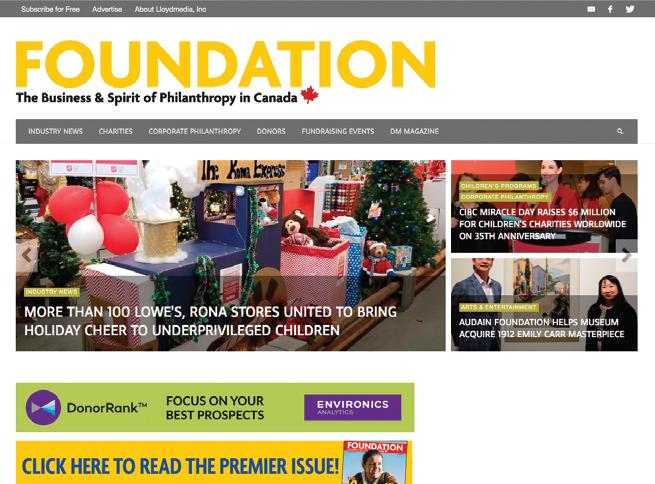
11 minute read
Setting Strategy, Donors and Technology
Inside The volving ole Of The Non-Profit CMO etting trategy, onors and echnology
By Ta nya Giovacc hini T he role of the non-profit chief marketing officer (CMOs) is changing to include not only what we think of as brand steward — communicating the brand and value proposition — but also that of “chief sense maker,” charged with using any (and all) tools at his or her disposal to reach out to, listen to, make sense of, and then adapt organizational strategy to the marketplace. Here, three CMOs talk about how their roles are changing and what it means to how they serve their constituents.
In today’s world, fulfilling a non-profit’s mission increasingly requires organizations to implement more sophisticated and complex systems and processes that enable it to meet the needs of diverse stakeholders. Technology and data collection form the heart of the shift by providing the raw inputs and feedback that form the basis for understanding stakeholder needs and adjusting organizational strategy to meet them. Increasingly, chief marketing officers (CMO), and professionals with similar roles, have taken on the responsibility of putting the systems and processes in place and ensuring their effectiveness to their organizations.
In the words of Kevin Conroy, chief product officer of GlobalGiving: “No longer is marketing just about having the biggest megaphone. It’s about developing relationships with your customers. We’re replacing, ‘Hey, you need to fundraise in GlobalGiving. Here’s our pricing!’ with ‘Hey, there are different ways you can think about crowdfunding. We’re a great resource for you’!”
Translating feedback into actions DonorsChoose.org is an online charity that connects donors with public school teachers seeking funding for their projects. According to its website, the firm has raised over $345,346,000 to fund more than 609,500 projects that have helped over 15,388,000 students. You can’t boast those kinds of numbers without listening to your stakeholders.
Katie Bisbee, DonorsChoose.org’s chief marketing officer, leaves no channel untapped in her constant collection of customer feedback. Live interviews, phone conversations, email surveys, website widgets, social media, and a small but highly productive customer relations team that fields as many as 1,500 inquiries a week from teachers and donors deliver what Bisbee calls “perpetual feedback about what our donors
he new CM has to serve donors, stakeholders and also be “chief sense maker”.
care about, what their questions are, and whether our website gives them what they need.”
No feedback loop is complete until it is shared with, understood by, and acted on by the company itself. Bisbee takes the same high-touch approach to internal mind sharing as she does to external stakeholders. She meets weekly with her staff as well as her managerial counterparts on the web product, customer relations, and data science teams. In an organization of only 70 employees, the chances are pretty good that Bisbee regularly meets with most of them.
The process culminates in the weekly “marketplace meeting,” in which the CEO, chief technology officer (CTO), and CMO Bisbee “connect the dots” gathered from thousands of separate data points. From this they set priorities for the coming week and mine the information that can help shape the organization’s strategy long term.
Finding the sweet spots The American Heart Association (AHA) comprises over 100 local offices, more than 3,000 employees, an amazing volunteer base, and has an extensive network of partners, with whom it collaborates to deliver its mission and maximize impact.
On top of this, the AHA’s overall mission of helping people “to build healthier lives, free of cardiovascular diseases and stroke,” is driven by numerous focus areas including: wellness, nutrition, multicultural, healthy living, stroke, and others.
Still, much like Bisbee at DonorsChoose.org, the AHA’s top marketing strategist, Gerald E. Johnson II, is responsible for ensuring that AHA’s mindsets in this decentralized organization are pulling in the same direction. “One of my roles is to force strategic conversations... while preserving geographical, cultural, and marketplace diversity across markets,” says Johnson, who simultaneously holds the title of chief diversity officer and senior vice president, marketing. One way the AHA inspires strategic conversations is decidedly lowtech but an important part of its overall information gathering: it regularly convenes thought leaders who can help them wrestle with priorities related to its mission. “We have tremendous people on staff, but where we really get to solving population wide issues and needs is by convening the best thought leaders across industry — science, medical, consumer, community, etc. — to combine forces and accelerate the speed of solution development,” Johnson says. “We use market research insights, both qualitative and quantitative, and ethnographic research to understand attitudes and behaviors and make sense of what is going on in the population and at the local levels,” he adds.
Complementing its research priorities is its focus on using social media as an integral part to AHA’s ability to uncover issues of importance. “Social is the currency of life for us right now,” says Johnson. With communities for different conditions associated with heart health and science communities, the AHA hears from heart/stroke survivors, moms, caregivers—people who want to live strong, healthy lives. Through these, he’s able to monitor conversations and determine the role AHA can play in meeting stakeholder needs. “Yes, we measure keywords and word clouds,” Johnson says, “but we also look at the geography of word clouds and ask ourselves, ‘Where is our sweet spot in all of this noise?’”
For example, a conversation among parents on Twitter or Facebook about childhood obesity might include inquiries not only about simple and nutritious recipes, but also references to restaurant choices, exercise options, and limiting entertainment technology in the home. Such conversations, Johnson explains, may reveal keyword associations offering clues to how the AHA might broaden its message delivery platform around how it talks about diet.
Sometimes social media locates an opportunity to help those you serve have more impact. For instance, when the DonorsChoose.org’s social media coordinator noted the poor quality of the images teachers were posting of their successfully funded projects, he suggested better guidelines to ensure image quality. This way, teachers learned how to post better quality images, which in turn helped them better promote, and get more buzz for, funding their projects.
Other times, social media reveals a new strategic opportunity — or tells you when it’s a rabbit hole. “For example, some of our stakeholders Tweeted about their interest in a DonorsChoose. org app,” recalls Bisbee. “After tweeting back and forth about what they would actually use the app for, we determined that we should focus on other products ahead of an app.” Building a learning loop GlobalGiving — the world’s first and largest crowd-funding platform for non-profits has connected more than 482,000 donors with nearly 13,000 non-profit projects. Since it started in 2013, nearly $192 million has been raised by non-profits using the GlobalGiving.org platform. Yet Chief Product Officer Kevin Conroy says it’s not all about the money, at least not entirely so. “Our hypothesis is that organizations that track learning will become more impactful,” says Conroy. “We want organizations that are becoming more impactful over time to get more funding on our platform and from others as well. It’s not just around who can raise the most money. It’s about how you’re going to be able to learn, create change, and affect the highest absolute impact. Isn’t that what all of us want to support?” To accomplish this, GlobalGiving is launching an “effectiveness framework” for their non-profit customers to track their learning and impact over time. Over the next 10 years, GlobalGiving will provide non-profits that list on GlobalGiving with the analytical tools they need to listen to their constituents, collect feedback, reflect on what has worked and what hasn’t, and outline how they’re going to change the project.
“It’s really about building a better customer, a better constituent, a better beneficiary,” says Conroy. Give customers the tools that they need to make change happen and they will remember you as having a role in their success. Becoming more technology driven Conroy says as the role of CMOs becomes more “technology centered and focused,” so too will hiring decisions. “We’re not going to grow by hiring hundreds of more people,” Conroy flatly admits. “We’re hoping to grow by hiring 10 more people who can help us quadruple the size of our program using technology and social media and digital marketing.”
GlobalGiving has already achieved extraordinary scale with its technology edge, requiring just one program officer for every 2,000 grantees rather than the industry standard of one officer per dozen or so grantees. “About building a better customer, a better constituent, a better beneficiary.”
Bisbee, who is the process of hiring a new marketing associate, concurs. “I guess that in the future, hiring a bright, young person who thinks like a marketer and is analytical isn’t going to cut it,” she reflects. “I think we’ll need people with expertise in online community building and digital marketing and deep analytics capabilities.”
In any case, Conroy’s final advice to CMOs everywhere captures an important organizational truism: if you feel like you’re butting heads with your technology team, that’s your number one problem to fix. “As soon as you can collaborate with your technology team to improve your communication, marketing, and email systems, you can hit levels of scale that you didn’t think were possible.”
Tan a G ova h n is a partner and chief engagement and marketing officer at The Bridgespan Group. The author would like to thank Bridgespan’s Lindsay O’Connell and Carole Matthews, as well as writer David Moore, for assisting in the research, editing, and writing of this article.
Top Five Trends In Philanthropy For 2020
Con n ed f o
page 41
build unique donor profiles and target them with personalized messages to make giving easier than ever before. That being said, it is difficult to harness the power of AI and data effectively and well so consider the added value an expert could bring to your organization. Start exploring, build the case for your board and get on with it! 5 Beyond Benefits: Showcasing Other Advantages, an HR Challenge There is a labour shortage and the charitable sector is feeling it hard. Where most charities can’t offer huge salaries like the corporate world, they can offer other incentives that are arguably just as important to attract and retain talent. Often overlooked, an organization’s values and philosophies can be an important factor for talent attraction and
retention. People are increasingly looking to work at companies or organizations whose values align with their own. Nonprofits need to make sure that their hiring practices and marketing elevate and reflect their cause and unique social culture.
Equally as important is to place an emphasis on collective well-being. Introducing a flexible working conditions or a four-day working week results in increased motivation, productivity and better work-life balance. For instance, here at Phil, our sick days are called “wellness days” placing the focus on preventive rather than reactive self-care. Well into the 21st century, it is clear that the way we work has changed. In this new decade, let’s take the lead on reflecting that change. Talk to us about planning a corporate culture workshop, reviewing your hiring practices or improving your internal communication channels.
The horizon ahead Non-profit organizations will have to step up their game and rise to meet donors’ expectations. Gone are the days of passively pushing out letters and waiting for cheques to roll in during annual campaigns. The only way you can afford to implement new practices, is by letting go of old ones that no longer yields results, and drain the organization of potential. By nurturing more personal relationships and making strategic changes to practices long-held as gold standards, the future will be bright for those willing to embrace the forwardthinking ethos of the new roaring 20’s.
K e is Founder & CEO of Phil, a consulting and marketing agency for non-profits, based in Montreal and Toronto.
Twelve Payment Predictions Which Might Change our FinTech Strategy
Con n ed f o
page 42
12. Invisible Payments Invisible payments are dominating the payments industry with the likes of payments rings, Uber and Amazon Go, all of which are completely frictionless, with payment details stored inside the product. Across all sectors in 2020, businesses will need to keep up with convenience-led lifestyles, placing it at the heart of financial services product design.
on a a n is Director of Solution Development at Ingenico Banks & Acquiring.
ow To Chart The Best Path For our New Supporter
Con n ed f o
page 44
existing donors. A donor who makes an annual $100 donation may have the capacity to give significantly more—you may need to reach that person with the right message and ask to unlock that potential.
With the outlook for the Canadian economy projected to tighten this year, now is a great time to pause and evolve the decision-making process to ensure shorter-term goals are met and longerterm priorities do not get lost.
en av dov leads Environics Analytics’ Not-For-Profit Practice. He has more than 15 years of experience helping charities of all sizes use #DataForGood to achieve their fundraising goals.
isit www.foundationmag.ca for breaking news, additional features and more great content.










